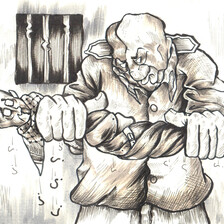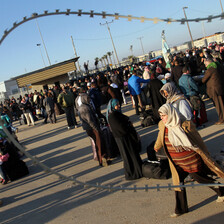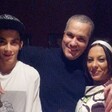The Electronic Intifada Ramallah 27 May 2014
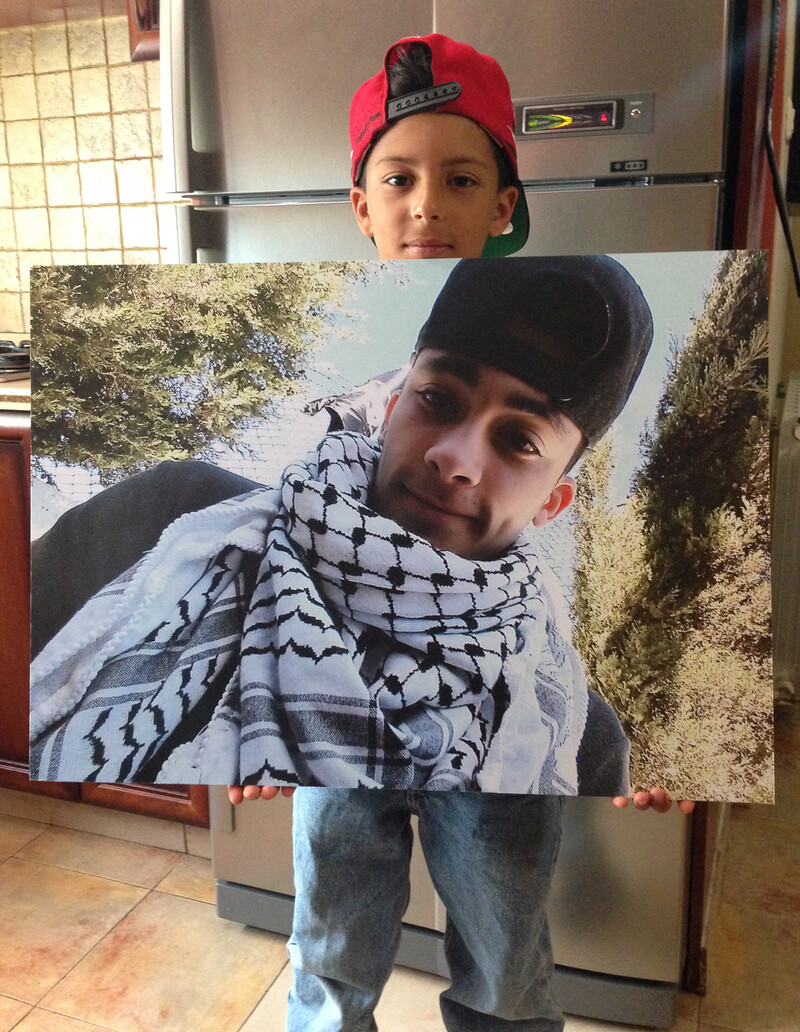
Daniel Nuwara holds a portrait of his slain brother, Nadim.
Nahil Nuwara, also known as Um Nadim, cannot hold back tears when she speaks about her son Nadim, who was fatally shot by the Israeli army on 15 May during a protest near the city of Ramallah in the occupied West Bank.
Sixteen-year-old Muhammad Mahmoud Odeh Abu al-Thahir was also fatally shot with live ammunition at almost exactly the same spot as Nuwara approximately an hour later. Both shootings were caught on video by a security camera installed at a nearby store.
“My son was a sweet and innocent boy,” Um Nadim told The Electronic Intifada at her home in Ramallah.
Approximately two hundred demonstrators gathered that day outside the Ofer military prison to show solidarity with hunger-striking Palestinian political prisoners in Israeli jails.
They were also commemorating the sixty-sixth anniversary of the Nakba, the 1948 ethnic cleansing of their homeland before and after Israel’s establishment.
When confrontations broke out between the demonstrators and the Israeli army, soldiers responded with force and live ammunition. CNN video images have shown the soldiers firing at the demonstrators, who posed no conceivable threat, from a long distance.
The two boys are among the more than 1,400 Palestinian children killed by Israeli soldiers or settlers since 2000, according to Defence for Children International - Palestine (DCI-Palestine), a group that monitors violations of Palestinian children’s human rights.
Israeli military forces have shot and killed four Palestinian children or teenagers so far this year, including Nadim Nuwara.
Another two persons were injured by live ammunition during the protest — one of them, Muhammad al-Azza, is still in Ramallah Hospital.
Covered from every angle
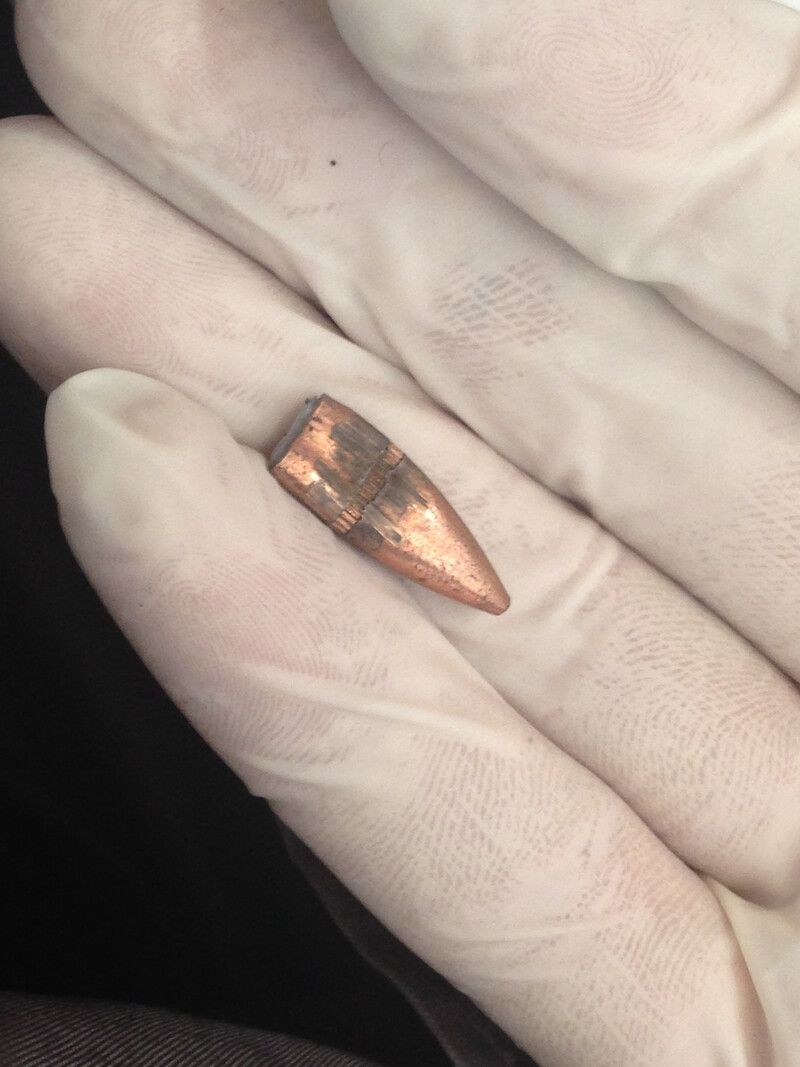
The bullet found in Nadim Nuwara’s backpack.
“On the way there we got a phone call saying that one child [Nadim] had already been shot,” Muhannad Drabee, a volunteer Red Crescent medic, told The Electronic Intifada.
Upon arriving, Drabee noticed the area was covered from every angle with Israeli soldiers and border police, who were using tear gas and rubber-coated steel bullets at that point.
“We all heard when live ammunition was fired,” he added. “I was about a meter away [from Muhammad Abu al-Thahir]. I ran and crouched when I heard it, but just for a second. When I looked back he was already falling to the ground.”
The bullet entered Muhammad’s back and passed through his heart. As Drabee was carrying him to the ambulance about 15 meters away, the boy stopped breathing. “I had my hand on his chest to stop the bleeding, and then he quit breathing and his heart stopped,” said Drabee.
Nadim Nuwara, however, died after being rushed to the hospital and admitted to surgery.
“Blessed to have him”
While growing up, Nadim had almost died twice before — once due to an illness shortly after his birth, and yet again when he was struck by a speeding car while in third grade at school.
Yet both times the child made a full recovery. “We were so blessed to have him after that,” Siam, his father, told The Electronic Intifada.
His father, mother, older sister and younger brother described Nadim as an affectionate, patient and innocent child. They explained that amid the flurry of statistics and heated political debates, the media too often robs Palestinian children killed by Israel of their individuality.
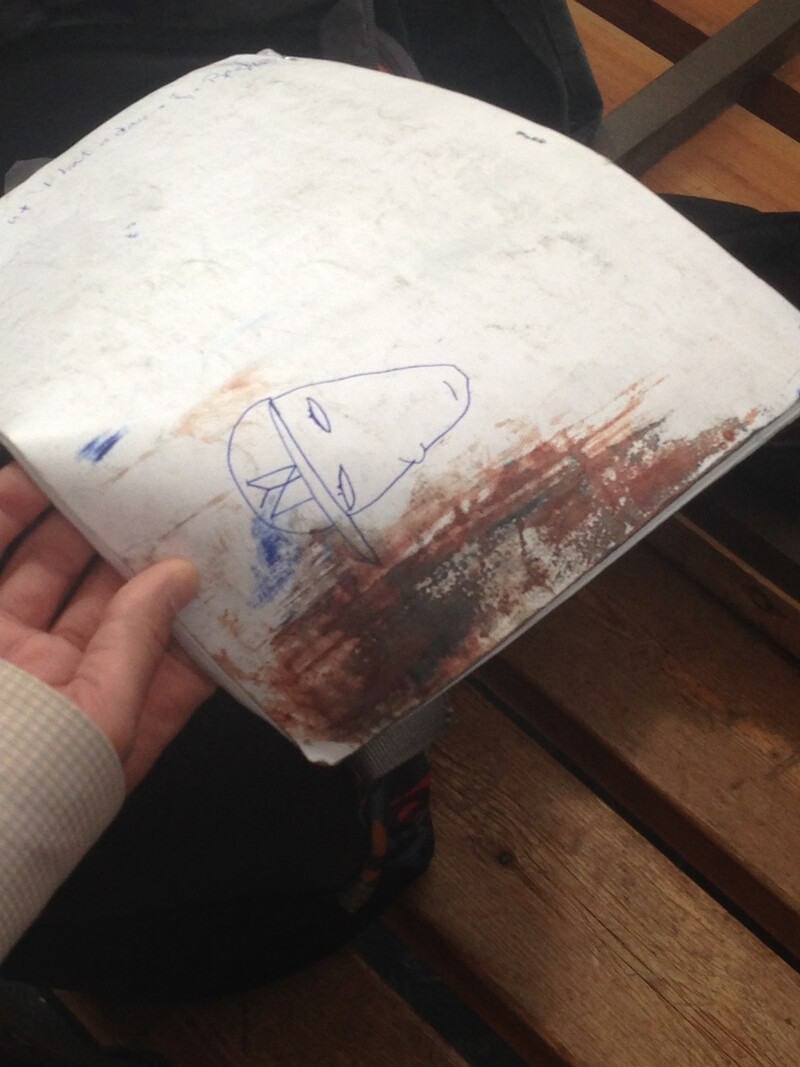
A blood-stained book found in Nadim Nuwara’s backpack.
“All of his friends have visited us since he died,” Daniel, his ten-year-old brother, said. “They said they will be my brothers now, that if I need anything, they will help me.”
“One of the first things we did together was when he taught me how to play basketball,” Daniel said, adding that Nadim used to spend several nights a week staying out late with friends and playing sports.
“I thought this summer was going to be very fun with my brother,” said Daniel. “I thought Nadim and I were going to be able to play together a lot. But he’s gone now and this is going to be a very bad summer.”
Following their son’s death, the parents have received an outpouring of support from the local community. The Saint George School in Ramallah, where Nadim was in eleventh grade, renamed an auditorium after him and hosted a public memorial to celebrate the boy’s life.
“I was scared”
Siam and Um Nadim did not allow their children to participate in protests, and as far as they know, the day he died was the first time Nadim had gone to a demonstration.
Two days before his death, Daniel told his parents that Nadim was planning to go to a protest for Nakba Day. Conscious that the Israeli military frequently injures and kills Palestinians during demonstrations, Um Nadim pleaded with him not to go to any marches or protests.
“I went and told him that I wouldn’t let him go protest because I was scared for him,” Um Nadim said. “But he got very angry because he didn’t want me to control him … so I went and asked his father to speak to him.”
On the morning of 15 May, the day Nadim died, his father asked him not to go to any protests for his mother’s sake.
“He agreed, but deep down I knew that he would go,” Siam said. “That day I prayed that God would protect him.”
At around 1:15pm that day, Siam called Nadim to make sure that his son hadn’t gone to the protest. “He told me he was in Ramallah,” Siam said. “I warned him again not to go to the protest. That was the last time I spoke to him.”
A little over an hour later, Nadim’s uncle called Siam and let him know that Nadim had been shot and was in the hospital.
Siam arrived at the hospital to doctors telling him that his son was losing blood rapidly and had little chance of surviving. According to a medical report provided by Ramallah Hospital (embedded at the bottom of this page), Nadim died at 2:45pm during surgery. The cause of death listed states that the boy’s “heart stopped during surgery and it couldn’t be revived.”
The video footage of the shootings provides a disturbing look at the two teens’ last moments. Security camera footage released by DCI-Palestine show Nadim walking by himself without any confrontations taking place as he is shot.
Muhammad was struck from behind while walking away and died on the scene. As human rights groups continue to condemn the killings, the United Nations and the United States have called on Israel to carry out an investigation.
Amnesty International denounced Israeli forces’ “continuing recklessness in their use of force against Palestinian protesters” (“Amnesty condemns Israel for ‘reckless’ Nakba Day killings,” Maan News Agency, 16 May 2014).
B’Tselem, an Israeli human rights group, expressed “grave suspicion that [Israeli] forces willfully killed two Palestinians [and] injured two others” that day.
In response, the Israeli military and government have claimed that the army was not using live ammunition at Ofer that day, that Palestinians may have killed the children, and that the video footage was possibly “forged,” as reported by the Israeli daily Haaretz (“IDF says forgery likely in video showing Palestinian teens’ deaths,” 22 May 2014).
“Contradictory”
Ayed Abu Eqtaish, the accountability director for DCI-Palestine, explained that the Israeli military still hasn’t provided a credible response to the evidence.
“So far the Israelis haven’t provided a response,” Abu Eqtaish told The Electronic Intifada. “They should go ahead and provide an official comment to the video we released … Because what they have been saying in the media is contradictory.”
The Israeli military has also accused the Palestinian Authority of failing to cooperate during its investigation. Siam Nuwara, however, said that the PA has had little to no involvement in uncovering the events of his son’s death.
“The Palestinian Authority has given us no support whatsoever,” Siam said, adding that no one from the PA visited the family until the day it was announced that the bullet that killed Nadim was found. “Where were they before that?” he asked.
Four days after Nadim’s death, the family discovered a bullet in the boy’s blood-covered backpack. A ballistics expert — who requested to remain anonymous — informed the Nuwara family that it was a 5.56mm Ball M193.
According to the website of Israeli Military Industries (IMI) — a weapons manufacturer — this type of bullet is in use by the Israeli military .
In January, IMI announced that it had begun production of a new version of the 5.56mm cartridge called “Razor Core.” The bullet “designed for use by military and law-enforcement forces” has what IMI termed “superior accuracy, effective stopping power and extended range.” It describes the Razor Core bullet as “combat-proven by an undisclosed customer.”
While visiting the family, PA representatives pressured them to hand over the bullet so that they could conduct an investigation.
“I refused to give them the bullet,” Siam said. “We want to move forward according to international human rights law and the Palestinian Authority does not have the means to undertake the investigation our son deserves.”
Adding that past PA investigations into the killings of Palestinians failed to produce meaningful results, Siam said the Nuwara family is still considering how to proceed. Aware that Israeli courts offer little hope of justice for Palestinians, they are considering taking legal action in an international forum.
The Nuwara family and the family of Muhammad Abu al-Thahir appealed publicly to Pope Francis, who visited Palestine this week, to help them bring their sons’ killers to justice. But the Pope completed his visit without making any specific comments about the boys or Israel’s victimization of Palestinian children.
The family doubts there can be genuine justice for Israel’s victims. Israel “killed my son in cold blood,” Siam said.
“He was a 17-year-old child wearing a backpack, and they sentenced him to death because he wanted to express his opinion … to say that he still hasn’t forgotten about our 66 years of Nakba.”
A correction has been made to this article. Muhammad Abu al-Thahir was struck from behind, rather than in the chest, as was stated in an earlier version.
All images courtesy of the Nuwara family.
Patrick O. Strickland is an independent journalist and frequent contributor to The Electronic Intifada. His writing can be found at www.patrickostrickland.com. Follow him on Twitter: @P_Strickland_.
